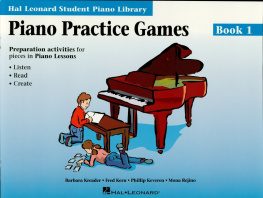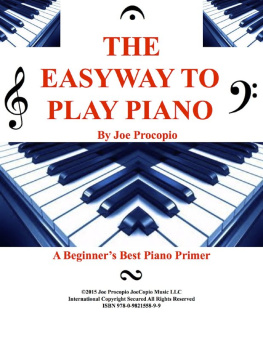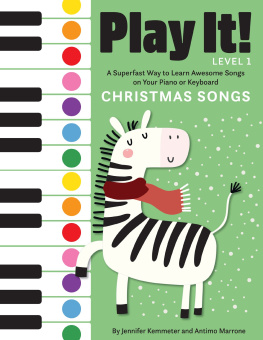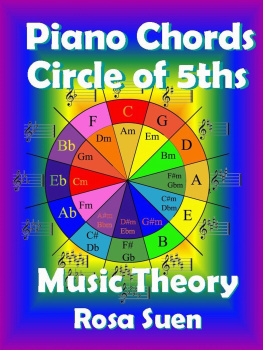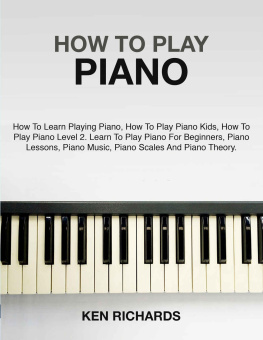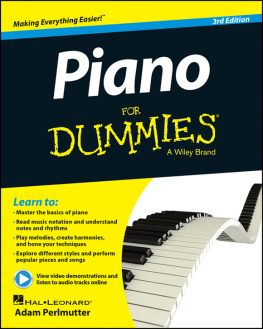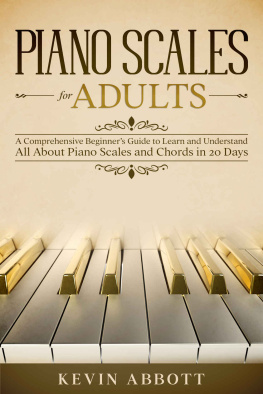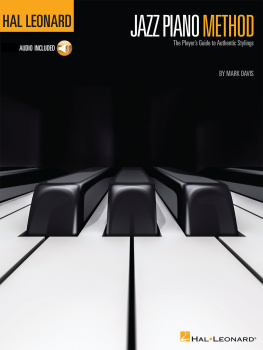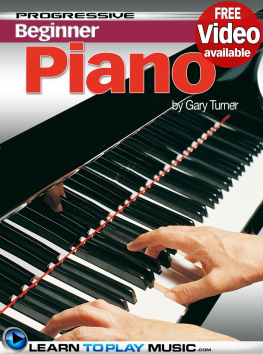
The Only
Basic Piano
INSTRUCTION BOOK YOULL EVER NEED
Learn to Playfrom Reading Your First Notes to Constructing Complex Chords
BROOKE HALPIN

Adams Media
Avon, Massachusetts
Copyright 2006, F+W Media, Inc.
All rights reserved. This book, or parts thereof, may not be reproduced in any form without permission from the publisher; exceptions are made for brief excerpts used in published reviews. Contains portions of material adapted and abridged from The Everything Playing Piano and Keyboards Book by Brooke Halpin, 2002, Adams Media Corporation.
Published by Adams Media, a division of F+W Media, Inc., 57 Littlefield Street, Avon, MA 02322. U.S.A. www.adamsmedia.com
ISBN-13: 978-1-59337-380-1 Printed in Canada. J I H G F E D C
ISBN-10: 1-59337-380-5
eISBN: 978-1-44051-780-8
Library of Congress Cataloging-in-Publication Data available from publisher.
This publication is designed to provide accurate and authoritative information with regard to the subject matter covered. It is sold with the understanding that the publisher is not engaged in rendering legal, accounting, or other professional advice. If legal advice or other expert assistance is required, the services of a competent professional person should be sought.
From a Declaration of Principles jointly adopted by a Committee of the American Bar Association and a Committee of Publishers and Associations
Many of the designations used by manufacturers and sellers to distinguish their products are claimed as trademarks. Where those designations appear in this book and Adams Media was aware of a trademark claim, the designations have been printed with initial capital letters.
Music copyright Halpin House Music. All Rights Reserved.
This book is available at quantity discounts for bulk purchases.
For information, please call 1-800-289-0963.
CONTENTS
Introduction
Ray Charles. Elton John. Vladimir Horowitz. Billy Joel. You.
Question: What do these five people have in common?
Answer: All of them, at one point in their lives, didnt know how to play the piano.
Its true, you still dont know how to play the piano, or at least play more than a little, and everyone else on the list eventually went far past that point. But even Mozart had to start somewhere. (Of course, he had the advantage of starting by age three.)
Listening to the glorious music of your piano heroes can be inspiringits no doubt part of what inspired you to pick up this bookbut also daunting. More so than with any other instrument, the way that ten fingers can use a piano to create a cascade of musical sound can seem miraculous, and beyond the capability of someone without remarkable talent. This can be true even if you have limited goals. You arent trying to race through a Beethoven sonata at breakneck speed like Horowitz, but youd like to know how to play a simple Bach prelude. You dont hope to tour the world as a famous singer-songwriter; youd be happy to play Just the Way You Are in your living room.
The important thing to remember is this: You have what it takes. You have that piano in the family room that youve been meaning to play, or you have the willingness to go out and find the right piano to buy or rent. You have an appreciation for the music a piano can make, and the desire to create some of it yourself. And you have The Only Basic Piano Instruction Book Youll Ever Need. Put it all together, along with some dedicated practice time, and you will be able to achieve at least some of your piano-playing dreams.
In this book, youll start with the basics of selecting and caring for a piano, learn what you need to know about music terminology and notation, and begin to play the pianofirst with your right hand, then your left, and finally with both. Later chapters will explore the mysteries of key signatures, sharps, flats, chords, and more. Along the way, youll do exerciseseighty in allthat make the concepts clear and gradually develop your abilities. There may be times when your new second language of music is hard to understand (root position? enharmonic equivalents?), and when your own progress is hard to see. Dont worry. Just take a deep breath, and go back through the exercise or that section of a chapter one more time. And keep playing.
one

How to Choose and
Care for Your Piano
BUYING A PIANO can be a major decision financially, and learning to play one takes a significant investment of your time. Before you rush off to purchase an impressive grand piano thats too big for your budget and your living room, or a worn-out upright thats quite cheap (but, unfortunately, unplayable), consider the following advice on how to select and care for the piano thats just right for you.
Before You Go Shopping for a Piano
You should first determine which room in your home or apartment is best suited to accommodate a piano. (You should try, for example, to place the piano far away from the television.) For the professional musician who spends a lot of time playing the piano, it might be best to put the piano in a spare room or guest bedroom.
Next, figure out how much money you are willing to spend. If you have a big apartment or home and really want a grand piano but have a small budget, you can make a down payment and finance the remaining balance.
What youre willing to pay for a piano will also determine whether you buy a new or used piano. New pianos are generally more expensive than used or restored pianos. An exception would be a rare restored piano, which might cost considerably more than a new piano.
Settle on a Size and Style
What you can afford to spend, along with the space you have available, will usually determine the size of the piano. The most affordable pianos are spinets and consoles, which are the smallest acoustic pianos made. Spinets are good for beginners, but very few piano manufacturers make new spinets. Consoles are the next size up and cost a little more than spinets. Studio pianos are even bigger in size and price. Upright pianos are taller and more expensive than studios.
All of the above varieties are vertical pianos, meaning that the soundboard and the piano strings are placed vertically. Grand pianos, which are the most expensive, have strings that run horizontally. They range in size from petite (or baby) grands to concert grands.
All types of pianos come in a variety of finishes, including high-gloss black, satin black, cherry, mahogany, walnut, or oak. The style of the casing also has several varieties, including modern, French Provincial, Italian Provincial, Queen Anne, and Louis XVI. You want to choose a piano that blends in with the overall style and design of the room youre going to put it in.

Most of the pianos that you might buy are made in the United States, Germany, or Asia. The primary U.S. manufacturers are Baldwin and Steinway, and to a smaller extent, Mason & Hamlin and Charles R. Walter. Steinway also makes pianos in Germany, which tend to be more expensive than their American models. Other German manufacturers include Blthner, Bechstein, Grotrian, Schimmel, and Seiler. Asian manufacturers include Kawai, Knabe, Samick, Yamaha, and Young Chang.
Next page

